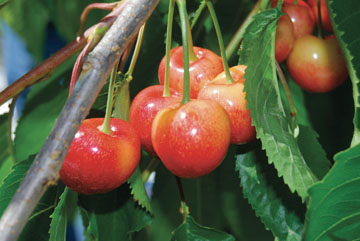 (NC)—They’re petite, iconic, delicious and only come around once each year. Many people can’t stop eating them after they tear into a bag: welcome to the spell cast by northwest cherries. With cherry trees now in full blossom, a flavourful crop is on its way. Peak season brings an abundance of sweet, picked-at-perfection cherries of all varieties from June through the third week of August. For the cherished Rainier cherry in particular, shipments typically run from late June through late July, and these pampered treats will be gone as quickly as they arrived in the store.
(NC)—They’re petite, iconic, delicious and only come around once each year. Many people can’t stop eating them after they tear into a bag: welcome to the spell cast by northwest cherries. With cherry trees now in full blossom, a flavourful crop is on its way. Peak season brings an abundance of sweet, picked-at-perfection cherries of all varieties from June through the third week of August. For the cherished Rainier cherry in particular, shipments typically run from late June through late July, and these pampered treats will be gone as quickly as they arrived in the store.
For those who haven’t indulged, the Rainier is that shiny golden cherry sporting a red blush seen at the market next to its dark red neighbours. It’s beloved for its crisp bite and pale yellow flesh bursting with exceptional sweetness.
In the northwest United States, where the variety originated, growers have perfected techniques to give the cherries optimum sweetness, size and colour. Rainiers reach exceptional sugar content levels, ideally 20 or more brix and no less than 17 brix; compare this to a perfectly sweet peach, whose brix measures about 13, and the sweetness of a Rainier cherry cannot be denied.
The Rainier is a cross between a Bing and a Van; both are sweet-red varieties. Harold Fogle, who once directed the cherry breeding program at the Washington State University (WSU) extension station in Prosser, Washington, crossed the cherries in 1952 intending to create a pollinator for the Bing. Due to the fruit’s popularity, it was released in 1960 to the masses. The original tree still lives on a WSU plot not far from the station. Now in its 51st year on the market, the Rainier has become a runaway hit.
Northwest Cherries, a five-state U.S. grower association, which produces two-thirds of the nation’s cherry crop, cites the Northwest United States’ rare mesoclimates and rich volcanic soils for their flavour and proliferation. The delicate treatment of their sweet, tender cherries during harvesting, packing and shipping are what keep them pristine from tree to the market shelf.
Rainier cherry orchards receive a great deal of care in early spring, beginning with tree pruning. If the tree is too branchy, the cherries don’t have room to grow. Sunlight gives the cherry its blush colour and sweetness. Savvy growers space their trees 2-3 metres apart; as the trees mature, this spacing allows maximum sunlight under the canopy.
Rainiers are picked by their stems and placed gently into a basket. Picking starts from the outside of the tree in, top to bottom, only picking what is ripe. Pickers may return to a single tree up to seven times, capturing Rainiers only at the peak of ripeness.
Northwest cherries of all varieties are shipped to more than 62 countries including Canada, and bring an economic boon of close to $500 million (USD) to the Northwest during its two-and-a-half month season. These cherries, whose growing region is comprised of Washington, Idaho, Utah, Oregon, and Montana, produce the Bing, Rainier, Lapin, Skeena, Sweetheart, Chelan and Tieton varieties, among others.
After the summer bounty, consumers can still enjoy cherries through easy preservation methods. You can learn more about Northwest cherries and their preservation, and get great recipes online at www.nwcherries.com or www.sweetpreservation.com
www.newscanada.com
Latest posts by Canadian Home Trends (see all)
- Dining Room Design Tips - December 8, 2025
- Practical Luxury in Forest Grove - December 8, 2025
- The Hidden Value of Great Design - December 8, 2025






